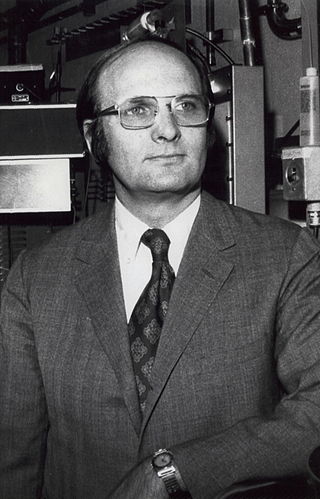
John Bardeen was an American physicist and electrical engineer. He is the only person to be awarded the Nobel Prize in Physics twice: first in 1956 with William Shockley and Walter Brattain for the invention of the transistor; and again in 1972 with Leon N. Cooper and John Robert Schrieffer for a fundamental theory of conventional superconductivity known as the BCS theory.

John Robert Schrieffer was an American physicist who, with John Bardeen and Leon Cooper, was a recipient of the 1972 Nobel Prize in Physics for developing the BCS theory, the first successful quantum theory of superconductivity.

Nick Holonyak Jr. was an American engineer and educator. He is noted particularly for his 1962 invention and first demonstration of a semiconductor laser diode that emitted visible light. This device was the forerunner of the first generation of commercial light-emitting diodes (LEDs). He was then working at a General Electric research laboratory near Syracuse, New York. He left General Electric in 1963 and returned to his alma mater, the University of Illinois at Urbana-Champaign, where he later became John Bardeen Endowed Chair in Electrical and Computer Engineering and Physics.
Shamit Kachru is an American theoretical physicist, a professor emeritus of physics at Stanford University, and a former Wells Family Director of the Stanford Institute for Theoretical Physics. He served as the Stanford Physics Department Chair from 2018 to 2021. He retired in 2023.

George D. Gollin is an American physics professor at the University of Illinois at Urbana-Champaign. Besides his work on particle physics and the International Linear Collider, he has since 2003 made numerous efforts in fighting institutions which are considered to be diploma mills, which has caused him to receive significant public attention. Gollin placed second in the 2014 Democratic primary for Illinois's 13th congressional district.
Brian Leeds DeMarco is a physicist and professor of physics at the University of Illinois at Urbana-Champaign. In 2005 he placed first in the quantum physics portion of the "Amazing Light" competition honoring Charles Townes, winner of the 1964 Nobel Prize in Physics. DeMarco is currently conducting experiments in quantum simulation.
Harry George Drickamer, born Harold George Weidenthal, was a pioneer experimentalist in high-pressure studies of condensed matter. His work generally concerned understanding the electronic properties of matter.
James R. Heath is an American chemist and the president and professor of Institute of Systems Biology. Previous to this, he was the Elizabeth W. Gilloon Professor of Chemistry at the California Institute of Technology, after having moved from University of California Los Angeles.
Gordon Alan Baym is an American theoretical physicist.
Matthias Staudacher is a German theoretical physicist who has done significant work in the area of quantum field theory and string theory.

Martin Gruebele is a German-born American physical chemist and biophysicist who is currently emeritus James R. Eiszner Chair in Chemistry, Professor of Physics, Professor of Biophysics and Computational Biology at the University of Illinois Urbana-Champaign.
George H. Miley is a professor emeritus of physics from the University of Illinois at Urbana–Champaign. Miley is a Guggenheim Fellow and Fellow of the American Nuclear Society, the American Physical Society and the Institute of Electrical and Electronics Engineers. He was Senior NATO Fellow from 1994 to 1995, received the Edward Teller Medal in 1995, the IEEE Nuclear and Plasma Science Award in Fusion Technology in 2003 and the Radiation Science and Technology Award in 2004. He holds several patents.
Nancy Makri is the Edward William and Jane Marr Gutgsell Endowed Professor of Chemistry and Physics at the University of Illinois Urbana–Champaign, where she is the principal investigator of the Makri Research Group for the theoretical understanding of condensed phase quantum dynamics. She studies theoretical quantum dynamics of polyatomic systems, and has developed methods for long-time numerical path integral simulations of quantum dissipative systems.
Arnold Theodore Nordsieck was an American theoretical physicist. He is best known for his work with Felix Bloch on the infrared problem in quantum electrodynamics. He developed the inertial electrostatic gyroscope (ESG) used as part of the inertial navigation system of nuclear submarines that allows them to remain underwater without having to surface to ascertain their location.
Shun Lien Chuang was a Taiwanese-American electrical engineer, optical engineer, and physicist. He was a Fellow of the IEEE, OSA, APS and JSPS, and professor at the University of Illinois at Urbana-Champaign.
David Kelly Campbell is an American theoretical physicist and academic leader. His research has spanned high energy physics, condensed matter physics and nonlinear dynamics. He also served as Physics Department Head at the University of Illinois at Urbana–Champaign, Dean of the College Engineering at Boston University, and Boston University Provost.
Philip W. Phillips is a theoretical condensed matter physicist at the University of Illinois at Urbana–Champaign. He has contributed to the studies of various topics in modern physics including high temperature superconductivity and gauge–gravity duality.
Steven Michael Errede is an American experimental physicist, known for his leadership in the collaboration that experimentally confirmed the existence of the top quark.
Paul Gregory Kwiat is an American physicist.
Smitha Vishveshwara is an Indian-American theoretical quantum condensed matter physicist whose research includes work on cold Bose gases and non-equilibrium quantum dynamics, as well as strongly correlated materials, dimensional confinement, fractionalization of quasiparticles, quantum quench dynamics, connections from condensed matter physics to protein structure networks, and quantum analogues of black hole collision ringdown. She is a professor of physics at the University of Illinois Urbana-Champaign.





